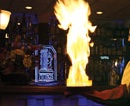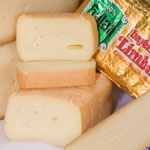
That would be me. Urp.
Monday = Cheese Day. We discussed and tasted beaucoup cheeses...some good, some okay, and....well, let's just say I did something that I've always wanted to do. One of those things that you've heard about all your life and may never have done. Yes, gentle readers, I brought in Limburger! Hee!
Chef said if we wanted to, and it was not required, we could stop by the grocery store and grab an interesting cheese for class. Don't spend a lot of money, he said, but get something out of the ordinary--no domestic Cheddar or Monterey Jack. So, I opted for Limburger. I figure we've all heard about it, maybe some people have even tried it, but it's worth the $2.99 I paid for it just for the experience, no? I also got a Greek cheese, kaseri, to try as well. (You can tell I went to the international farmer's market, can't you? I spent waaaay too much money, but it was fun! And, holidays are coming--you always spend more for holiday food...gotta have something to make a resolution about, don't ya?)
The kaseri (or kasseri) is the Greek version of mozzarella. It's a mild white cheese and most often used in Saganaki--the flaming cheese dish you find in a lot of Greek restaurants. The waiter brings the cheese, pours a liqueur on it, lights it up and screams "Opa!"
 Great fun. Because what's the only thing better than cheese? Why melted cheese, of course!
Great fun. Because what's the only thing better than cheese? Why melted cheese, of course! Limburger...the stuff of legends, an honorable mention in a B-52s song, and Looney Tunes staple, where a mere whiff of the stuff could curl your toes and knock you out or make your animated eyes spin in pain. Chef walked by our table and picked up the foil wrapped cheese and just grinned. I think he was pleased that I had brought it. I figured what the heck--I'm sure most of my classmates haven't tried it, but we've all heard about it, so take that Nike philosophy to heart and let's just do it.
Limburger is is made from cow's milk and is soft-ripened for about 3 months. It originated in Belgium and is now also made in the United States; however, most limburger comes from Germany. It's an innocous looking cheese,
 with a rind sort of like a Brie or a Camembert and the interior is soft and creamy, again like a Brie...an extremely well-aged Brie. A Brie that may have been buried for a month or two and dug up...kind of the kimchee of cheeses.
with a rind sort of like a Brie or a Camembert and the interior is soft and creamy, again like a Brie...an extremely well-aged Brie. A Brie that may have been buried for a month or two and dug up...kind of the kimchee of cheeses.Seriously, it was not as malodorous as it's been depicted on stage and screen. It is fairly pungent, and the pungency does increase the longer it ages, but it's by no means knock your socks off and curl your fashionably straight hair stinky. If you like strong cheeses, you might like Limburger. Then again, you might be ready for skunk jerky as well. I brought home what was left to challenge The Man with, and he was game. I'll check on it again in a few days and see if the stink factor has increased.
We had a couple of blues--a Danish, a Gorgonzola, and one of my faves--Saga Blue, which is a blue-veined Brie...that's my idea of heaven. Manchego, a hard Spanish goat cheese, is pretty tasty with quince paste; a quince is sort of a combination of pear and apple.
We also learned about how to serve cheese, as in setting up a cheese board for a customer or for a cheese course. There are 6 different types or textures of cheese: Fresh, Soft & Rind, Semi-soft, Hard, Grating, and Blue, and you should bear these textures in mind when creating a cheese course or platter.
 Don't put too many of the same texture, like both brie and camembert, which are soft, or strong flavors, like Gorgonzola and Stilton, on your platter. Balance is the key. And, do something to identify the different cheeses--little placards or flags or something to let your guests know what they are eating in case they like it or not. Chef said you would basically look like a doofus if YOU didn't know what the guest were eating, and they asked you about it. How hard is it to Google, I ask you?
Don't put too many of the same texture, like both brie and camembert, which are soft, or strong flavors, like Gorgonzola and Stilton, on your platter. Balance is the key. And, do something to identify the different cheeses--little placards or flags or something to let your guests know what they are eating in case they like it or not. Chef said you would basically look like a doofus if YOU didn't know what the guest were eating, and they asked you about it. How hard is it to Google, I ask you?Some fun cheese trivia: Maytag Blue is made in Iowa and was a collaboration between Iowa State University and the Maytag family farm...yep, that Maytag family of appliance fame. Also, Coach, the leather folks, have opened a cheese making business in upstate New York and are producing a very nice goat cheese (montrachet).
Happy Thanksgiving, with cheese or without! We're doing X-perimental Turky Day at our house--I'm brining a turkey for the first time, so I'll let you know how it goes. I'm using an Alton recipe, so I'm sure it's going to work out just fine. Now, off to make the cranberry congealed salad that feeds thousands!


2 comments:
I've always wondered - with rind cheeses, do you eat the rind? Does it depend on the cheese?
I think it depends on the cheese--you eat the rind on Brie-type cheeses, but not on something hard like Parmesan Reggiano. But, don't throw away the Parm rind, because it can be used to flavor soups (like minestrone) and other dishes.
Post a Comment